 |
The Great Barn of Coralan Farm
Menominee County, Michigan
|
Click the image above to see a larger
photograph.

| The place dear to my heart was called Coralan Farm,
which represented a melding of the words
"Corey" and "land." It was settled in
1882 by my great grandfather, Hiram Corey. My father,
Kenneth Corey, was born on the farm in 1915, as was my
oldest sister, Judy, nearly 30 years later. The Corey
roots went deep on that piece of Upper Peninsula land. The
farm is located three miles east of Stephenson, in
Menominee County. The barn was built by my grandfather,
Homer Corey, of timber cut from the land. The
double-thick, 40’ by 70’ stone basement wall
cost $70, the frame, another $500. When it was finished
the great barn was the best in the area for many years.
My father, would later write in his journal, "I have
always believed the reason my dad wanted the farm to stay
in the family was because of the barn."
|
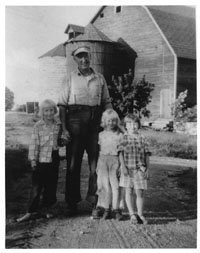 |
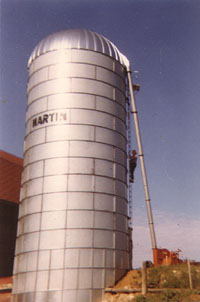 |
My dad loved the farm – and the great barn
– as much as his father before him. He took over the
farm in 1938 and two years later brought his bride, Mille
Palmer, there. Together they made many improvements. The
barn was immaculately maintained. Wood flooring was
replaced with concrete. Stanchions, automatic drinking
cups, a manure-cleaning system, and more stalls were
added. An addition on the east end housed heifers. A silo
room and steel Martin silo were added on the north side.
A big window added light to a new block milkhouse on the
south side where the bulk tank and milking equipment were
kept spotless. In the early 1960s, an addition was built
on the west end of the barn to provide box stalls for
cows due to calve, a row of stanchions for heifers, four
off-the-floor calf boxes, and more mow space. In
addition to all the demands of active farming, my parents
raised a huge vegetable garden to feed our family (Dad,
Mom and five girls), plus two boys who lived with us. We
planted a windbreak to shield the buildings from strong
westerly winds, landscaped the yard with a variety of
trees transplanted from the woods on the farm, and even
maintained the roadsides, keeping them clean and free of
brush. The crowning touch was Mom’s magnificent
flower beds.
|
| More than once, my parents’ Holstein herd was
named best in the Upper Peninsula. In addition, Dad
earned awards for his conservation practices and crop
production on 272 acres without the use of chemicals.
Coralan Farm became a popular stop on annual farm tours
arranged by the Michigan Milk Producers Association and
Michigan Farm Bureau. Thanks to Mom’s skills, the
basic two-story farm house also became a thing of beauty.
Indoor bathroom facilities came first and over the years
many improvements followed. Mom designed the layout for
the open, combined kitchen, dining, and living room
areas. Big picture windows faced south to capture the
afternoon sun and a red brick fireplace with hearth was
built on the north wall. Hardwood flooring gleamed.
Mom’s design was featured in a farm magazine.
|
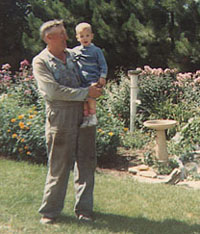 |
 |
Coralan Farm was a wonderful place to raise a family
and the great barn was the heart of it all. We milked the
cows there, filled the mow with hay and straw, and sat up
in the night with cows as they calved. But the barn was
also a place to build forts of hay, search for newborn
kittens, leap from the hay into loose straw, read books
by flashlight, and even camp out overnight. All five of
us girls shared secrets and dreamed dreams in the great
barn. |
| But, one by one each of my sisters graduated from
high school and went away to college. Dad’s health
was not good. He and Mom considered ways to keep the farm
without having 40 head of cattle to milk twice a day
– add more land and take on a partner? Just raise
young stock? Convert to beef or maybe even create a
"pleasure farm" for city people to visit?
Nothing was truly workable. You could say that my dad
died twice. The day he turned the farm over to new
owners, December 15, 1969, and the day he left this
earth, December 18, 1995. When Dad left Coralan Farm he
left a piece of himself behind and he grieved the rest of
his life. The farm was sold with great hopes that the
young couple who followed would have the same energies
and abilities that my parents’ had brought to it.
But sadly, they did not. Cattle went unmilked. Crops went
untended. Soon, an auction was held and everything was
sold off – cattle, equipment, everything. Dad
had to turn away when people mentioned it. We stayed away
from the sale and wept. The great barn wept too.
Another man bought the farm. For a time he let cattle
and pigs run freely in the barn. He rented the house out,
sometimes to two families at a time. But loving care was
a thing of the past. Scraggly trees have taken root along
the stone foundation of the barn. Sections of the roof
have failed and rain and snow have turned the haymow into
a molding wasteland. Burdocks grow through broken
windows. Fences lean, boards have been torn out of the
walls. The house desperately needs repair.
|
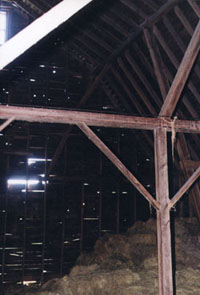 |
Although none of my sisters or I moved back to
Upper Michigan, my lifestyle comes closest to what we knew on the
farm. I go back to Stephenson once or twice a year, drawn there
by some powerful force. I sit in the haymow of the great barn and
feel the souls of my great grandfather, my grandfather, and my
father there with me.
I have hope in my heart that someone with a
spiritual connection to the land will buy the farm and restore it
to greatness. That is my fervent prayer for Coralan Farm.
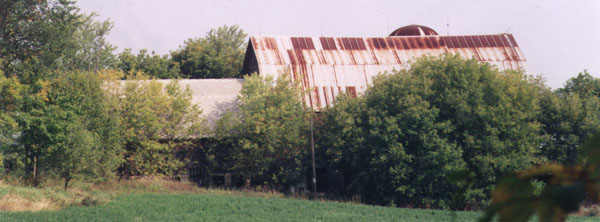
The Great Barn of Coralan Farm
today, consumed by destructive trees and their even more
destructive roots.
Postscript: Since this story was written in mid-1998
for Michigan Barn Preservation News, the house, barn, and
40 acres of Coralan Farm have been sold to a couple from Chicago,
Illinois who are already completely remodeling the house in
preparation for retiring there. Their goal is to return the farm
to the "showplace it once was," and, since seeing
photos of the barn in its prime, plan to restore and preserve it
as well. Prayers are being answered.
By Jan Corey Arnett � 1998

 About the Author: Jan Corey
Arnett is the youngest of the five girls who grew up on Coralan Farm. (Her father
was the youngest of the five boys born there.) All five girls left Upper Michigan
to attend college in Lower Michigan and remained there to pursue careers --
two as teachers, one in government service, one as a nurse, and Jan as a writer.
She is an award-winning author and photographer and operates a freelance business
called Coralan Communications in addition to writing a newspaper column and
doing workshops on preserving family history. (A story which took place on Coralan
Farm in the 1960s appears in the April 1999 issue of Guideposts magazine.)
Jan can be reached at coralan@net-link.net or (616) 968-2510.
She is pictured here with Kenna, named for her father Ken Corey.
About the Author: Jan Corey
Arnett is the youngest of the five girls who grew up on Coralan Farm. (Her father
was the youngest of the five boys born there.) All five girls left Upper Michigan
to attend college in Lower Michigan and remained there to pursue careers --
two as teachers, one in government service, one as a nurse, and Jan as a writer.
She is an award-winning author and photographer and operates a freelance business
called Coralan Communications in addition to writing a newspaper column and
doing workshops on preserving family history. (A story which took place on Coralan
Farm in the 1960s appears in the April 1999 issue of Guideposts magazine.)
Jan can be reached at coralan@net-link.net or (616) 968-2510.
She is pictured here with Kenna, named for her father Ken Corey.

Back to The Barn Journal front page.

![]()

![]()
 About the Author: Jan Corey
Arnett is the youngest of the five girls who grew up on Coralan Farm. (Her father
was the youngest of the five boys born there.) All five girls left Upper Michigan
to attend college in Lower Michigan and remained there to pursue careers --
two as teachers, one in government service, one as a nurse, and Jan as a writer.
She is an award-winning author and photographer and operates a freelance business
called Coralan Communications in addition to writing a newspaper column and
doing workshops on preserving family history. (A story which took place on Coralan
Farm in the 1960s appears in the April 1999 issue of Guideposts magazine.)
Jan can be reached at coralan@net-link.net or (616) 968-2510.
She is pictured here with Kenna, named for her father Ken Corey.
About the Author: Jan Corey
Arnett is the youngest of the five girls who grew up on Coralan Farm. (Her father
was the youngest of the five boys born there.) All five girls left Upper Michigan
to attend college in Lower Michigan and remained there to pursue careers --
two as teachers, one in government service, one as a nurse, and Jan as a writer.
She is an award-winning author and photographer and operates a freelance business
called Coralan Communications in addition to writing a newspaper column and
doing workshops on preserving family history. (A story which took place on Coralan
Farm in the 1960s appears in the April 1999 issue of Guideposts magazine.)
Jan can be reached at coralan@net-link.net or (616) 968-2510.
She is pictured here with Kenna, named for her father Ken Corey.![]()